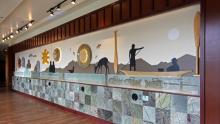UW’s Center for American Indian and Indigenous Studies (CAIIS) hosts a liɬgʷəč̓əb ʔiišəd (‘research family’) focusing on advanced Lushootseed study and data collection. The group of undergraduates, graduate students, community members and faculty members works under the guidance of Tami Hohn (Puyallup). The indigenous language of eastern Puget Sound may no longer have any first language speakers, but Lushootseed is nonetheless alive and well.
And near and dear to the heart of some UW linguists
Graduate student Ted Kye began his study of Lushootseed while an undergraduate at Evergreen State College, through Prof. Rebecca Chamberlain, a friend and student of the late Vi Hilbert, an Upper Skagit elder who taught Lushootseed at UW for several years. There Ted was introduced to a variety of grammatical materials, particularly those of the late Thom Hess (UW Linguistics PhD 1967), and learned about traditional Salish myths and culture from heritage speaker Lois Landgrebe of Tulalip. He also met UW’s Laurel Sercombe, head of the Ethnomusicology Archive, and was allowed to access recordings from the Vi Hilbert, Thom Hess, and Leon Metcalf collections. After studying these materials and listening to recordings of native elder speakers of Lushootseed, Ted became fascinated with the grammar of the language. “I was particularly drawn to the phonetics, phonology, and morphology of the language. I recall spending 3-5 hours a day studying Lushootseed, practicing with speaking and pronouncing in the language.” Now starting his third year of graduate work at UW, Ted’s research focuses on the phonetics, phonology, and morphology of Lushootseed. Most of his class papers have involved some aspect of Lushootseed grammar. His first generals paper is a study of the effects of uvular consonants on vowel quality, using archival recordings. His second generals paper is a comprehensive survey of the valency-changing operators in Lushootseed verbal morphology. He has several other phonetic studies underway: acoustic properties of ejectives, vowels adjacent to rounded consonants, vowel reduction and undershoot.
Undergraduate Stuart Heslop, has been studying Lushootseed for about three years at UW, following exposure to it in high school. When he found out about a new class in Lushootseed at UW, he registered for it, loved it, and developed a strong relationship with the instructor Tami Hohn and the other students. He and other students wanted to continue beyond the one formal year of class, so Stuart worked with Tami to set up a semi-formal second year of study, receiving funding from UW’s Center for American Indian and Indigenous Studies, to come together as the aforementioned liɬgʷəč̓əb ʔiišəd (‘research family’) under Tami's guidance and Stuart’s facilitation. Their studies draw on Tami’s teachings of Southern Lushootseed UW and her other expertise, as well as the work of the 1994 Lushootseed Dictionary, now online. Ted Kye has also recently joined the group, which is currently annotating and transcribing recordings that took place between anthropologist Warren Snyder and speaker Amelia Sneatlum, a Suquamish elder. As part of his work as the facilitator of the group, Stuart has been preparing a morpheme index of these recordings.
Challenge yourself with this Lushootseed interlinear glossed text puzzle, from Annie Daniels’ Bluejay story, courtesy of Ted Kye. Can you figure out the free translation from the morpheme glosses?
day̓=əxʷ ʔəs-ʔab-ši-d tə s-qʷəb~qʷbayʔ-s ʔə tiiɬ x̌ʷəs
just=now stat-extend-appl-tr det nmlz-pl~dog-3.poss obl det fat
The answer is in the pdf version of this newsletter.
